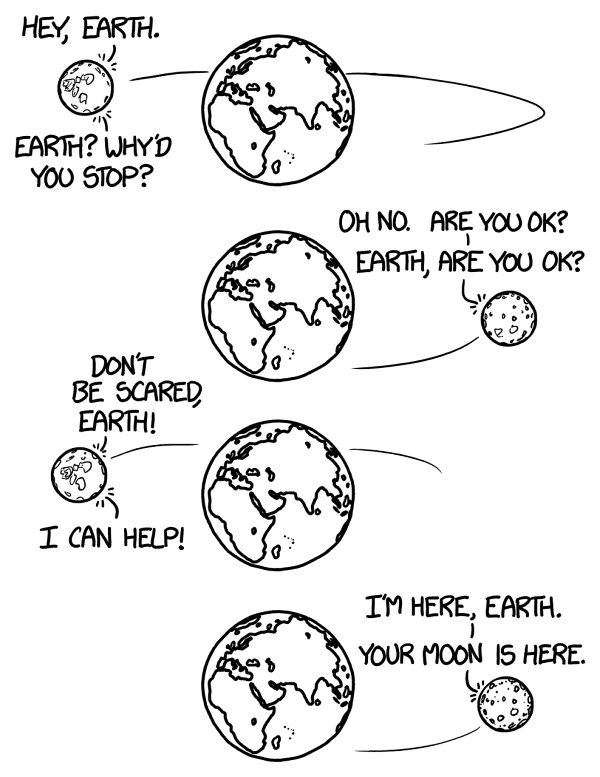What If?
Authors: Randall Munroe


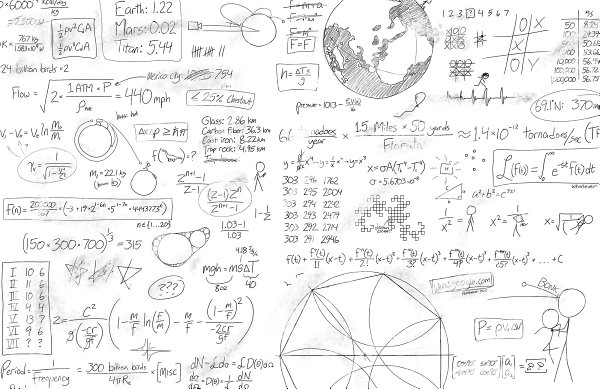
what if?
Serious Scientific Answers to Absurd Hypothetical Questions
RANDALL MUNROE
HOUGHTON MIFFLIN HARCOURT
2014 • BOSTON • NEW YORK
Copyright © 2014 by xkcd Inc.
all rights reserved
For information about permission to reproduce selections from this book, write to Permissions, Houghton Mifflin Harcourt Publishing Company, 215 Park Avenue South, New York, New York 10003.
The Library of Congress has cataloged the print edition as follows:
Munroe, Randall, author.
What if? : serious
scientific answers to absurd hypothetical questions / Randall Munroe.
pages cm
isbn
978-0-544-27299-6 (hardback)
isbn
978-0-544-45686-0 (international pbk.)
1. Science
—
Miscellanea. I. Title.
q
173.m965 2014
500
—
dc23
2014016311
Book design by Christina Gleason
Lyrics from “If I Didn’t Have You” © 2011 by Tim Minchin.
Reprinted by permission of Tim Minchin.
e
isbn
978-0-544-27264-4
v1.0914
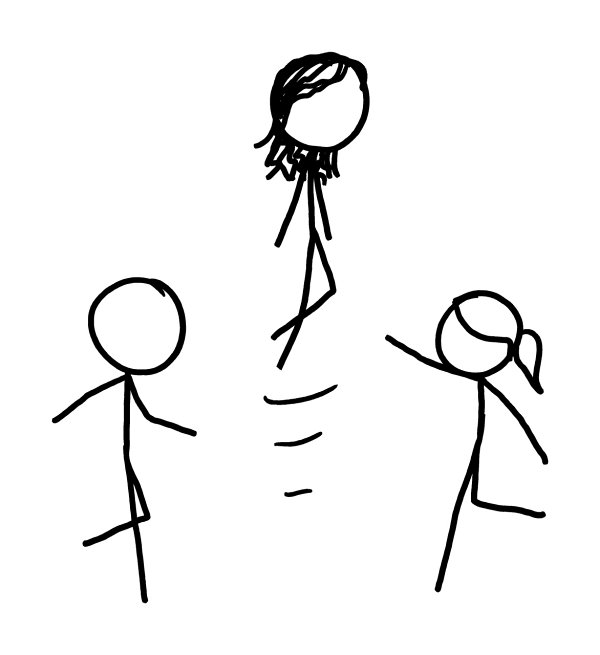
Questions
Disclaimer
[>]
Introduction
[>]
Global Windstorm
[>]
Relativistic Baseball
[>]
Spent Fuel Pool
[>]
Weird (and Worrying) Questions from the What If? Inbox, #1
[>]
New York–Style Time Machine
[>]
Soul Mates
[>]
Laser Pointer
[>]
Periodic Wall of the Elements
[>]
Everybody Jump
[>]
A Mole of Moles
[>]
Hair Dryer
[>]
Weird (and Worrying) Questions from the What If? Inbox, #2
[>]
Th
e Last Human Light
[>]
Machine-Gun Jetpack
[>]
Rising Steadily
[>]
Weird (and Worrying) Questions from the What If? Inbox, #3
[>]
Orbital Submarine
[>]
Short-Answer Section
[>]
Lightning
[>]
Weird (and Worrying) Questions from the What If? Inbox, #4
[>]
Human Computer
[>]
Little Planet
[>]
Steak Drop
[>]
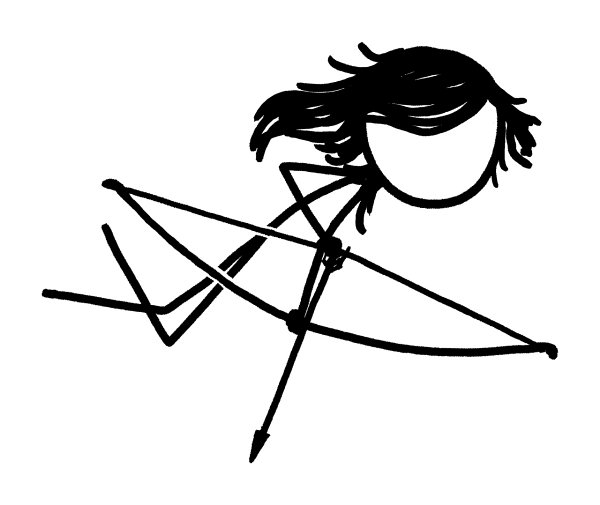
Hockey Puck
[>]
Common Cold
[>]
Glass Half Empty
[>]
Weird (and Worrying) Questions from the What If? Inbox, #5
[>]
Alien Astronomers
[>]
No More DNA
[>]
Interplanetary Cessna
[>]
Weird (and Worrying) Questions from the What If? Inbox, #6
[>]
Yoda
[>]
Flyover States
[>]
Falling with Helium
[>]
Everybody Out
[>]
Weird (and Worrying) Questions
from the What If? Inbox, #7
[>]
Self-Fertilization
[>]
High
Th
row
[>]
Lethal Neutrinos
[>]
Weird (and Worrying) Questions from the What If? Inbox, #8
[>]
Speed Bump
[>]
Lost Immortals
[>]
Orbital Speed
[>]
FedEx Bandwidth
[>]
Free Fall
[>]
Weird (and Worrying) Questions from the What If? Inbox, #9
[>]
Sparta
[>]
Drain the Oceans
[>]
Drain
the Oceans: Part II
[>]
Twitter
[>]
Lego Bridge
[>]
Longest Sunset
[>]
Random Sneeze Call
[>]
Weird (and Worrying) Questions from the What If? Inbox, #10
[>]
Expanding Earth
[>]
Weightless Arrow
[>]
Sunless Earth
[>]
Updating a Printed Wikipedia
[>]
Facebook of the Dead
[>]
Sunset on the British Empire
[>]
Stirring Tea
[>]
All the Lightning
[>]
Loneliest Human
[>]
Weird (and Worrying) Questions from the What If? Inbox, #11
[>]
Raindrop
[>]
SAT Guessing
[>]
Neutron Bullet
[>]
Weird (and Worrying) Questions from the What If? Inbox, #12
[>]
Richter 15
[>]
Acknowledgments
[>]
References
[>]

Disclaimer
Do not try any of this at home.
The author of this book is an Internet cartoonist, not a health or safety expert. He likes it when things catch fire or explode, which means he does not have your best interests in mind. The publisher and the author disclaim responsibility for any adverse effects resulting, directly
or indirectly, from information contained in this book.
Introduction
Th
is book is a
collection of answers to hypothetical questions.
Th
ese questions were submitted to me through my website, where
—
in addition to serving as a sort of Dear Abby for mad scientists
—
I draw xkcd, a stick-figure webcomic.
I didn’t start out making comics. I went to school for physics, and after graduating, I worked on robotics at
NASA
. I eventually
left
NASA
to draw comics full-time, but my interest in science and math didn’t fade. Eventually, it found a new outlet: answering the Internet’s weird
—
and sometimes worrying
—
questions.
Th
is book contains a selection of my favorite answers from my website, plus a bunch of new questions answered here for the first time.
I’ve been using math to try to answer weird questions for as long as I can
remember. When I was five years old, my mother had a conversation with me that she wrote down and saved in a photo album. When she heard I was writing this book, she found the transcript and sent it to me. Here it is, reproduced verbatim from her 25-year-old sheet of paper:
Randall:
Are there more soft things or hard things in our house?
Julie:
I don’t know.
Randall:
How about in the
world?
Julie:
I don’t know.
Randall:
Well, each house has three or four pillows, right?
Julie:
Right.
Randall:
And each house has about 15 magnets, right?
Julie:
I guess.
Randall:
So 15 plus 3 or 4, let’s say 4, is 19, right?
Julie:
Right.
Randall:
So there are probably about 3 billion soft things, and . . . 5 billion hard things. Well, which one wins?
Julie:
I guess hard things.
To this day I have no idea where I got “3 billion” and “5 billion” from. Clearly, I didn’t really get how numbers worked.
My math has gotten a little better over the years, but my reason for doing math is the same as it was when I was five: I want to answer questions.
Th
ey say there are no stupid questions.
Th
at’s obviously wrong; I think my question about hard
and soft things, for example, is pretty stupid. But it turns out that trying to thoroughly answer a stupid question can take you to some pretty interesting places.
I still don’t know whether there are more hard or soft things in the world, but I’ve learned a lot of other stuff along the way. What follows are my favorite parts of that journey.
randall munroe
what if?
Global Windstorm
Q.
What would happen if the Earth and all terrestrial objects suddenly stopped spinning, but the atmosphere retained its velocity?
—Andrew Brown
A.
Nearly everyone would die.
Th
en
things would get interesting.
At the equator, the Earth’s surface is moving at about 470 meters per second
—
a little over a thousand miles per hour
—
relative to its axis. If the Earth
stopped and the air didn’t, the result would be a sudden thousand-mile-per-hour wind.
Th
e wind would be highest at the equator, but everyone and everything living between 42 degrees north and 42 degrees south
—
which includes about 85 percent of the world’s population
—
would suddenly experience supersonic winds.
Th
e highest winds would last for only a few minutes near the surface; friction
with the ground would slow them down. However, those few minutes would be long enough to reduce virtually all human structures to ruins.
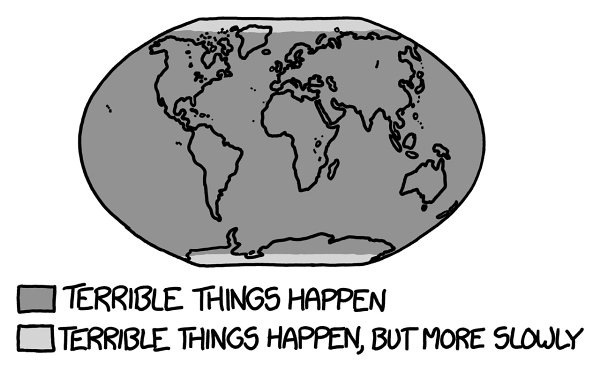
My home in Boston is far enough north to be just barely outside the supersonic wind zone, but the winds there would still be twice as strong as those in the most powerful tornadoes. Buildings, from sheds to skyscrapers, would be smashed flat, torn from their foundations, and sent tumbling across the landscape.
Winds would be lower near the poles, but no human cities are far
enough from the equator to escape devastation. Longyearbyen, on the island of Svalbard in Norway
—
the highest-latitude city on the planet
—
would be devastated by winds equal to those in the planet’s strongest tropical cyclones.
If you’re going to wait it out, one of the best places to do it might be Helsinki, Finland. While its high latitude
—
above 60°N
—
wouldn’t be enough to keep it from being
scoured clean by the winds, the bedrock below Helsinki contains a sophisticated network of tunnels, along with a subterranean shopping mall, hockey rink, swimming complex, and more.
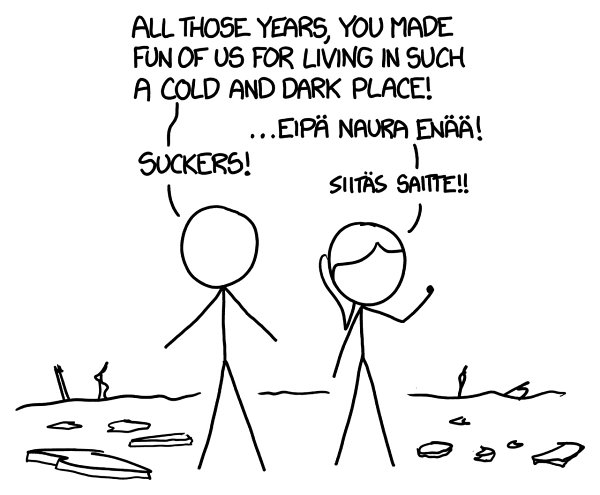
No buildings would be safe; even structures strong enough to survive the winds would be in trouble. As comedian Ron White said about hurricanes, “It’s not
that
the wind is blowing, it’s
what
the wind is blowing.”
Say you’re in a massive bunker made out of some material that can withstand thousand-mile-per-hour winds.
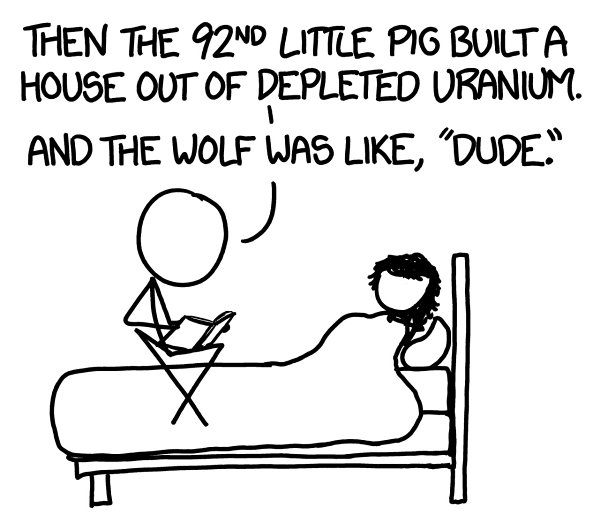
Th
at’s good, and you’d be fine . . . if you were the only one with a bunker. Unfortunately, you probably have neighbors, and if the neighbor upwind of you has a less-well-anchored bunker, your bunker will have to withstand a thousand-mile-per-hour impact by
their
bunker.
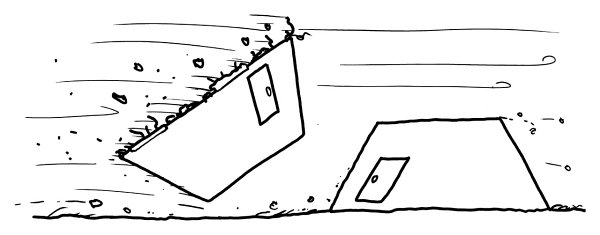
Th
e human race wouldn’t go extinct.
1
In general, very few people above the surface would survive; the flying debris would pulverize anything that wasn’t nuclear-hardened. However, a lot of people below the surface of the ground would survive just fine. If you were in a deep basement (or, better yet, a subway tunnel) when it happened, you would stand a good chance of surviving.
Th
ere would be other lucky survivors.
Th
e dozens of scientists and staff at the Amundsen–Scott research station at the South Pole would be safe from the winds. For them, the first sign of trouble would be that the outside world had suddenly gone silent.
Th
e mysterious silence would probably distract them for a while, but eventually someone would notice something even stranger:
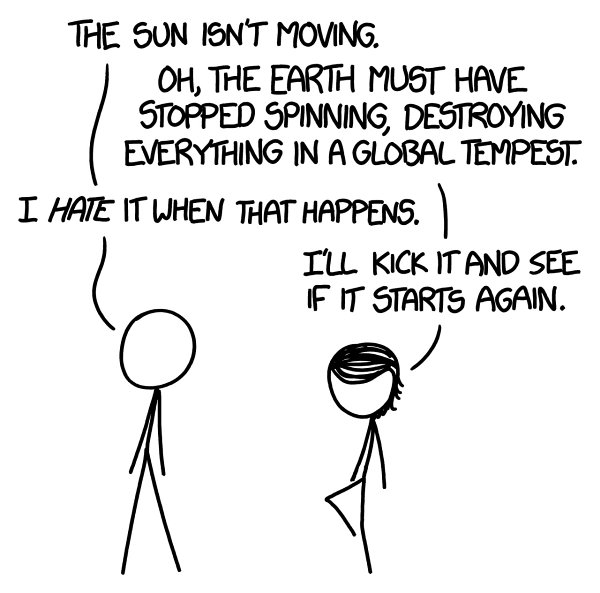
The air
As the surface winds died down, things would get weirder.
Th
e wind blast would translate to a heat blast. Normally, the kinetic energy of rushing wind is small enough to be negligible, but this would not be normal wind. As it tumbled to a turbulent stop, the air would heat up.
Over land, this would lead to scorching temperature increases and
—
in areas where the
air is moist
—
global thunderstorms.
At the same time, wind sweeping over the oceans would churn up and atomize the surface layer of the water. For a while, the ocean would cease to have a surface at all; it would be impossible to tell where the spray ended and the sea began.
Oceans are
cold
. Below the thin surface layer, they’re a fairly uniform 4°C.
Th
e tempest would churn up cold water
from the depths.
Th
e influx of cold spray into superheated air would create a type of weather never before seen on Earth
—
a roiling mix of wind, spray, fog, and rapid temperature changes.
Th
is upwelling would lead to blooms of life, as fresh nutrients flooded the upper layers. At the same time, it would lead to huge die-offs of fish, crabs, sea turtles, and animals unable to cope with the influx
of low-oxygen water from the depths. Any animal that needs to breathe
—
such as whales and dolphins
—
would be hard-pressed to survive in the turbulent sea-air interface.
Th
e waves would sweep around the globe, east to west, and every east-facing shore would encounter the largest storm surge in world history. A blinding cloud of sea spray would sweep inland, and behind it, a turbulent, roiling
wall of water would advance like a tsunami. In some places, the waves would reach many miles inland.
Th
e windstorms would inject huge amounts of dust and debris into the atmosphere. At the same time, a dense blanket of fog would form over the cold ocean surfaces. Normally, this would cause global temperatures to plummet. And they would.
At least, on one side of the Earth.
If the Earth
stopped spinning, the normal cycle of day and night would end.
Th
e Sun wouldn’t completely stop moving across the sky, but instead of rising and setting once a day, it would rise and set once a
year
.
Day and night would each be six months long, even at the equator. On the day side, the surface would bake under the constant sunlight, while on the night side the temperature would plummet. Convection
on the day side would lead to massive storms in the area directly beneath the Sun.
2
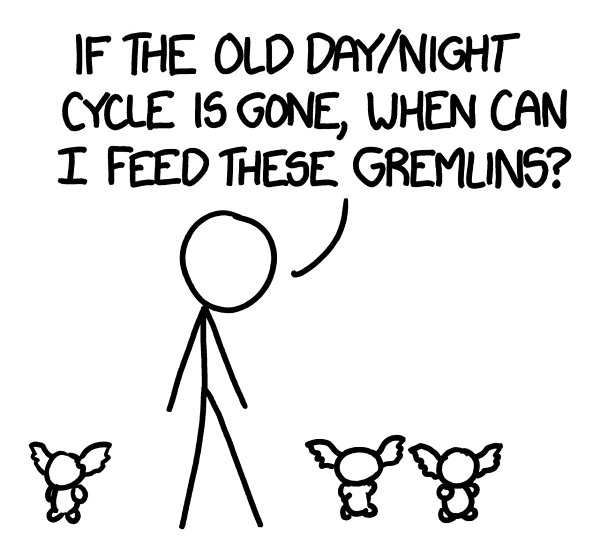
In some ways, this Earth would resemble one of the tidally locked exoplanets commonly found in a red dwarf star’s habitable zone, but a better comparison might be a very early Venus. Due to its rotation, Venus
—
like our stopped Earth
—
keeps the same face pointed toward the Sun for months at a time. However, its thick atmosphere circulates quite quickly, which results in the day and
the night side having about the same temperature.
Although the length of the day would change, the length of the month would not!
Th
e Moon hasn’t stopped rotating around the Earth. However, without the Earth’s rotation feeding it tidal energy, the Moon
would
stop drifting away from the Earth (as it is doing currently) and would start to slowly drift back toward us.
In fact, the Moon
—
our
faithful companion
—
would act to undo the damage Andrew’s scenario caused. Right now, the Earth spins faster than the Moon, and our tides slow down the Earth’s rotation while pushing the Moon away from us.
3
If we stopped rotating, the Moon would stop drifting away from us. Instead of slowing us down, its tides would accelerate our spin. Quietly, gently, the Moon’s gravity would tug on our planet
. . .
